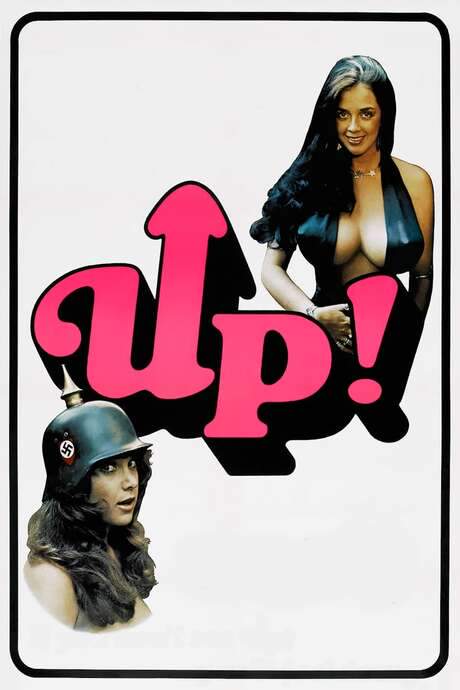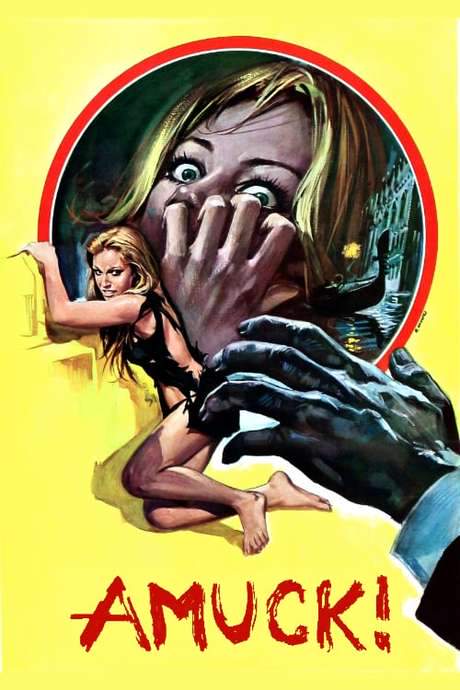
Up!
Year: 1976
Runtime: 80 mins
Language: English
Adolf Hitler has assumed the alias Adolf Schwartz and is living hidden in California when he is abruptly killed by an unidentified shooter. At the same time a mysterious woman arrives in a nearby town, drawing the attention of many residents. While the murder goes largely ignored, curiosity surrounding the newcomer intensifies.
Warning: spoilers below!
Haven’t seen Up! yet? This summary contains major spoilers. Bookmark the page, watch the movie, and come back for the full breakdown. If you're ready, scroll on and relive the story!
Up! (1976) – Full Plot Summary & Ending Explained
Read the complete plot breakdown of Up! (1976), including all key story events, major twists, and the ending explained in detail. Discover what really happened—and what it all means.
The Greek Chorus, Kitten Natividad, opens the film with a provocative narration that recurs between scenes, nude except for long black boots, reminding viewers of the film’s brazen tone while quietly guiding the audience through shifting plots and lurid details.
A man named Adolf Schwartz, Adolf Hitler in hiding, lives in a Bavarian-style castle in northern California. He is introduced in a scene that blends dark humor with unsettling decadence, an orgy in the dungeon involving [The Headsperson], [The Ethiopian Chef], Limehouse, and Paul, after which Schwartz is murdered when a ravenous piranha fish is slipped into his bathtub. The killer’s identity remains ambiguous for a moment, and the film’s tone shifts from shock to a sun-bleached surrealism as the story moves forward.
Margo Winchester hitchhikes into the nearby town of Miranda and is spotted by the local Sheriff Homer Johnson. He makes flirtatious advances, which Margo rebuffs, setting the stage for a tense, power-filled dynamic between the two. Shortly after, she is picked up by Leonard Box, a known troublemaker and the son of a sawmill owner. A heated argument escalates, and Leonard subdues and rapes an unconscious Margo; she regains consciousness and kills him in retaliation. Homer witnesses the act but covers it up, fearing that Leonard’s father could jail Margo forever and could retaliate against him. He uses the incident to his advantage, steering the narrative into a dangerous alliance that begins with Margo sleeping with him and grows into a relationship that is threaded with mutual but untrusting infidelity.
Homer helps Margo secure a job at the local diner, Alice’s, which is run by Alice, who is married to Paul. The film sketches a web of sexual dissatisfaction and desire, with Paul showing interest in Limehouse and causing a cascade of flirtations and encounters. After Margo finishes her shift and goes for a swim at Salmon Creek, Paul follows, and the two have sex. In a separate, almost offhand moment of raw power and control, Homer—who had earlier scuttled a traffic violation against a woman after a blowjob—remains in bed with the Native American Pocohontas and awkwardly shoves her out when Margo’s van returns. Still in the nude, Margo enters the house with her companion, while Homer, now in the shower, sustains an accidental scalding burn that leaves him humiliated and slightly chastened. The encounter prompts Margo to quip about his altered state, noting that she must have slept with an “Indian” to account for the red-tinted memory.
A bar performance by Margo sparks the attention of Rafe, a lumberjack. He reacts with anger, rapes Margo, and the others join in before fleeing at Homer’s arrival. The confrontation between Rafe and Homer ends in both men losing their lives, a stark reminder of the film’s cycle of violent impulses and fatal consequences.
Margo later discovers she is undercover and has been sent to Miranda to investigate the crime, revealing the ongoing investigation’s real purpose. A phone booth scene leads to a chase through the forest, where she is suddenly attacked by a figure in black—the assailant turns out to be Alice. Alice is Adolf Schwartz’s murderer and, it is revealed, his daughter. She killed Adolf out of jealousy that he slept with Paul and intends to do the same to Margo. After a muddy confrontation by a creek, Alice and Margo come to a tense reconciliation, and Alice guides Margo toward a bed frame standing alone in the forest. As the forest shelter gives way to danger, Paul appears and shoots Alice in revenge for Adolf, whom he loved. Margo disarms Paul and ultimately apprehends the two, bringing the chaotic chain of desire, deception, and murder to a close.
The film’s rhythm hinges on the narrator’s interludes by The Greek Chorus, whose provocative interruptions and comments frame each scene with a knowing wink at the audience. The characters’ entanglements ripple outward: a hidden war between lovers and would-be lovers, a series of betrayals both intimate and violent, and a detective’s dangerous operations that blur the line between crime, passion, and punishment. The performances by the principal players—especially Margo Winchester, whose journey from hitchhiking stranger to undercover investigator drives the narrative forward—are underscored by moments of dark humor and unflinching sexuality that have defined the work’s enduring reputation.
-
Margo Winchester’s arc grows through a sequence of coercive and consensual experiences that pull her deeper into a web of secrecy and danger. Raven De La Croix embodies the character’s blend of vulnerability and resolve as she navigates a world where power and desire often collide.
-
Homer Johnson’s presence—played by Monty Bane—serves as a catalyst for Margo’s decisions, a man whose male pride and protective impulses veer into manipulation and crime.
-
The diverse cast of players around Adolf Schwartz—Edward Schaaf in the role of the concealed dictator—renders the film’s morally ambiguous world with a satirical edge that remains unsettling to this day.
-
The grotesque allure of Limehouse, The Ethiopian Chef, and The Headsperson is kept vivid through their brief, charged appearances, each linked to the memorable performances of the actors who briefly animate the film’s more lurid episodes.
In the end, the narrative does not exhale closure so much as it leaves a trail of consequences: ruined relationships, buried secrets, and the unsettling reminder that behind every act of desire lies a motive, a fear, or a lie. The Greek Chorus remains a constant, winking oracle over it all, continually reminding the audience that the plot’s shocks are as much about human nature as about the film’s outrageous setups.
Last Updated: October 07, 2025 at 09:02
Unlock the Full Story of Up!
Don't stop at just watching — explore Up! in full detail. From the complete plot summary and scene-by-scene timeline to character breakdowns, thematic analysis, and a deep dive into the ending — every page helps you truly understand what Up! is all about. Plus, discover what's next after the movie.
Up! Timeline
Track the full timeline of Up! with every major event arranged chronologically. Perfect for decoding non-linear storytelling, flashbacks, or parallel narratives with a clear scene-by-scene breakdown.

Similar Movies to Up!
Discover movies like Up! that share similar genres, themes, and storytelling elements. Whether you’re drawn to the atmosphere, character arcs, or plot structure, these curated recommendations will help you explore more films you’ll love.
Explore More About Movie Up!
Up! (1976) Scene-by-Scene Movie Timeline
Up! (1976) Movie Characters, Themes & Settings
Up! (1976) Spoiler-Free Summary & Key Flow
Movies Like Up! – Similar Titles You’ll Enjoy
Surf Nazis Must Die (1987) Story Summary & Characters
Killing Hasselhoff (2017) Detailed Story Recap
Sex Up Your Life! (2005) Complete Plot Breakdown
Even Hitler Had a Girlfriend (1991) Movie Recap & Themes
The Uppercrust (1981) Movie Recap & Themes
Hell Hunters (1987) Detailed Story Recap
Amuck! (1972) Full Movie Breakdown
Up Yours (1979) Plot Summary & Ending Explained
The Hitler Tapes (1994) Movie Recap & Themes
Private House of the SS (1977) Spoiler-Packed Plot Recap
Hitler’s Kaput! (2008) Full Summary & Key Details
Hideous! (1997) Film Overview & Timeline
The Red Nights of the Gestapo (1977) Complete Plot Breakdown
Hitler- Dead or Alive (1942) Movie Recap & Themes
Up Your Alley (1971) Movie Recap & Themes

















